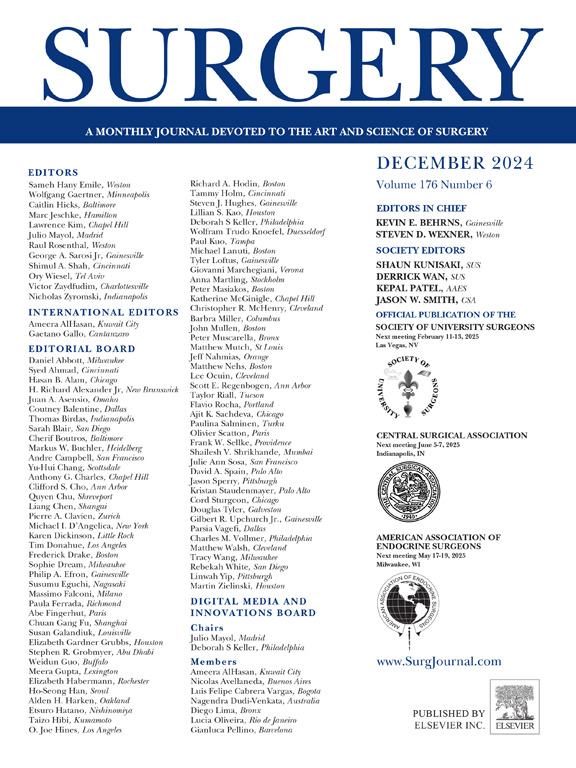基于机器学习的预测烧伤手术术中出血量模型的开发和验证
IF 2.7
2区 医学
Q1 SURGERY
引用次数: 0
摘要
背景:在烧伤患者的护理中,术中失血是一个关键问题。及时识别手术过程中大量失血风险升高的患者是必要的。方法收集患者的人口学资料、实验室检查结果及手术因素。为了预测术中出血量>;750 mL,将原始队列随机分为8:2的比例,较大的组用于模型开发,较小的组用于内部验证。使用逻辑回归、决策树、随机森林、k近邻、支持向量机和极端梯度增强等6种机器学习算法建立预测模型。通过8个指标以及密度曲线、校正曲线和决策曲线对模型的性能进行评价。设计了一个评分系统来评估性能效能。在另外2个队列中进行了验证。得到最优预测模型。最后,创建了一个基于网络的计算器来估计术中出血量>; 750ml的发生率。结果共分析了2家医院395例烧伤手术,其中245例为建模,89例为内外验证,61例为外部验证。模型特征由8个临床变量组成。随机森林模型的总指标得分最高,为36分,其次是支持向量机模型、极端梯度增强模型、k近邻模型、逻辑回归模型和决策树模型,其总得分分别为33、32、28、24和18分。具体而言,与其他模型相比,随机森林模型在大多数指标上表现优异,具有更高的准确率(0.776),召回率(0.930),F1分数(0.868),以及最低的对数损失(0.423)和Brier分数(0.142)。同时,随机森林模型表现出较强的性能,曲线下面积为0.784(95%置信区间0.779-0.789),仅次于极端梯度增强模型,曲线下面积最大,为0.785(95%置信区间0.780-0.790)。其他模型显示曲线值下的面积相对较小。随机森林模型的密度曲线、校正图、均值直方图和决策曲线也表现良好。在内外验证队列中,随机森林的总指标得分最高,为35分。在外部验证队列中,随机森林再次获得了最高的综合指标得分,达到38分。总体而言,随机森林模型是预测精度最优的模型。此外,初始血红蛋白、烧伤后开始手术的时间、初始血小板、切除和移植的体表总面积百分比、手术时间是预测术中出血量的前5个特征。随后,随机森林模型与其他5个模型一起被部署到网上,以便更广泛地访问。https://surgerybloodlosswebapp-m2jzz6hs87qu74vcfrhgz9.streamlit.app/.ConclusionThe随机森林模型是预测烧伤术中出血量>; 750ml发生率的一种有价值的人工智能工具。应该注意几个主要的预测因素。这6种机器学习算法已经被用来开发一个基于web的应用程序。这个平台将有助于后续的数据验证和系统优化。本文章由计算机程序翻译,如有差异,请以英文原文为准。

Development and validation of a machine learning–based model for predicting intraoperative blood loss during burn surgery
Background
Intraoperative blood loss is a critical issue in the care of patients with burns. The timely identification of patients at elevated risk for substantial blood loss during surgical procedures is imperative.
Methods
Demographic data, laboratory test results, and surgical factors of patients were collected. For predicting intraoperative blood loss >750 mL, the original cohort was randomly divided in an 8:2 ratio, with the larger group allocated for the model development and the smaller for internal validation. Six machine-learning algorithms, including logistic regression, decision tree, random forest, K-nearest neighbor, support vector machine, and extreme gradient boosting were used to develop the prediction models. The performance of the models was assessed by 8 metrics as well as density curve, calibration curve and decision curve. A scoring system was designed to assess the performance efficacy. Validation was conducted in another 2 cohorts. The optimal prediction model acquired. Ultimately, a web-based calculator to estimate the incidence of intraoperative blood loss >750 mL was created.
Results
A total of 395 burn surgeries from 2 hospitals were analyzed, with 245 surgeries for modeling, 89 surgeries for the internal-external validation, and 61 surgeries for the external validation. The model features consist of 8 clinical variables. The random forest model gained the greatest total metrics score of 36, followed by the support vector machine, extreme gradient boosting, K-nearest neighbor, logistic regression, and decision tree models with total scores of 33, 32, 28, 24, and 18, respectively. Specifically, the random forest model performed superior in most metrics compared to the other models, achieving greater accuracy (0.776), recall (0.930), F1 score (0.868), as well as the lowest log loss (0.423), and Brier score (0.142). Meanwhile, the random forest model demonstrated strong performance with an area under the curve of 0.784 (95% confidence interval, 0.779–0.789), ranking second only slightly behind the extreme gradient boosting model, which achieved the greatest area under the curve of 0.785 (95% confidence interval, 0.780–0.790). Other models showed comparatively lower area under the curve values. The density curve, calibration plot, histogram with mean predicted probabilities against counts and decision curve of the random forest model also performed well. In the internal-external validation cohort, the random forest reached the greatest total metrics score of 35. In the external validation cohort, the random forest again secured the greatest composite metrics score, amounting to 38. Overall, the random forest model was found to be the optimal model for predictive accuracy. In addition initial hemoglobin, time to start surgery after burn injury, initial platelets, % total body surface area excised and grafted, and duration of surgery were the first 5 features to predict intraoperative blood loss. Subsequently, the random forest model, along with the other 5 models, has been deployed online for broader accessibility. https://surgerybloodlosswebapp-m2jzz6hs87qu74vcfrhgz9.streamlit.app/.
Conclusion
The random forest model is a valuable artificial intelligence instrument for predicting the incidence of intraoperative blood loss >750 mL during burn surgery. Several principal predictors should receive attention. The 6 machine-learning algorithms have been used to develop a web-based app. This platform will facilitate subsequent data validation and system optimization.
求助全文
通过发布文献求助,成功后即可免费获取论文全文。
去求助
来源期刊

Surgery
医学-外科
CiteScore
5.40
自引率
5.30%
发文量
687
审稿时长
64 days
期刊介绍:
For 66 years, Surgery has published practical, authoritative information about procedures, clinical advances, and major trends shaping general surgery. Each issue features original scientific contributions and clinical reports. Peer-reviewed articles cover topics in oncology, trauma, gastrointestinal, vascular, and transplantation surgery. The journal also publishes papers from the meetings of its sponsoring societies, the Society of University Surgeons, the Central Surgical Association, and the American Association of Endocrine Surgeons.
 求助内容:
求助内容: 应助结果提醒方式:
应助结果提醒方式:


